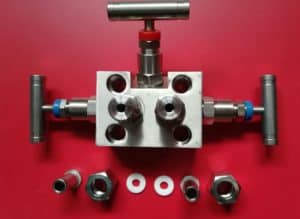Three Valve Manifold
3-Valve Manifold
- 1. Specification: 1 / 4NPT, 1 / 2NPT;
- Materials: A105, f304, f304l, F316, f316l;
- Pressure: ≤ 6000PSI;
- Temperature: PTFE ≤ 170 ℃;
3-Valve Manifold Introduction

The three valve manifold consists of a valve body, two globe valves and a balance valve. According to the operating procedures when the differential pressure transmitter is put into operation,
- open the two blowdown valves on the differential pressure transmitter,
- then open the balance valve,
- slowly open the two stop valves to remove the air or dirt in the impulse pipe,
- close the two blowdown valves,
- close the balance valve, and the transmitter can be put into operation.
Operating procedure for zero point online verification of differential pressure transmitter: first open the balance valve and close the two stop valves to verify the zero point of the transmitter.
Function of 3-Valve Manifold
The balance valve is required for the installation and removal of the three valve manifold. Otherwise, the differential pressure range is generally very small. If the manufacturer’s overload capacity is not strong, it is easy to be damaged. When the flow sensor instrument is connected to the process pipeline, the “three valve manifold” shall be used to:
- When the pipeline is filled with medium from the initial state (empty), the pressure on both sides of the sensor will suddenly change and the pressure difference will increase. To avoid this, close valves a and B on both sides of the sensor and open bypass valve C;
- After the medium fills the pipeline and becomes stable and balanced, gradually open a and B to apply pressure evenly on both sides of the sensor;
- Finally, close valve C and the sensor starts to work normally;
- The closing sequence is the reverse of the above. In addition, the three valve manifold has other functions, such as cleaning the pipeline after running for a period of time, and the sensor part is not affected (the pipeline is bypassed)
